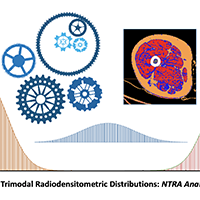Machine learning predictive system based upon radiodensitometric distributions from mid-thigh CT images

Accepted: 3 March 2020
HTML: 14
All claims expressed in this article are solely those of the authors and do not necessarily represent those of their affiliated organizations, or those of the publisher, the editors and the reviewers. Any product that may be evaluated in this article or claim that may be made by its manufacturer is not guaranteed or endorsed by the publisher.
The nonlinear trimodal regression analysis (NTRA) method based on radiodensitometric CT images distributions was developed for the quantitative characterization of soft tissue changes according to the lower extremity function of elderly subjects. In this regard, the NTRA method defines 11 subject-specific soft tissue parameters and has illustrated high sensitivity to changes in skeletal muscle form and function. The present work further explores the use of these 11 NTRA parameters in the construction of a machine learning (ML) system to predict body mass indexand isometric leg strength using tree-based regression algorithms. Results obtained from thesemodels demonstrate that when using an ML approach, these soft tissue features have a significant predictive value for these physiological parameters. These results further support the use of NTRA-based ML predictive assessment and support the future investigation of other physiological parametersand comorbidities.
Metter EJ, Talbot LA, Schrager M, Conwit R. Skeletal muscle strength as a predictor of all-cause mortality in healthy men. J Gerontol A Biol Sci Med Sci. 2002;57: B359-65. DOI: https://doi.org/10.1093/gerona/57.10.B359
Barberi L, Scicchitano BM, Musaro A. Molecular and Cellular Mechanisms of Muscle Aging and Sarcopenia and Effects of Electrical Stimulation in Seniors. Eur J Transl Myol2015;25:231-6. doi: 10.4081/ejtm.2015.5227. DOI: https://doi.org/10.4081/ejtm.2015.5227
Fanò-Illic G. Are deferrable the mobility impairments in older aging? Eur J Transl Myol2016;26:25-28. DOI: https://doi.org/10.4081/ejtm.2016.5831
Goodpaster BH, Carlson CL, Visser M, et al. Attenuation of skeletal muscle and strength in the elderly: The Health ABC Study. Journal of Applied Physiology (Bethesda MD: 1985) 2001;90:2157–65. DOI: https://doi.org/10.1152/jappl.2001.90.6.2157
Jiang F., Jiang Y., Zhi H., Artificial intelligence in healthcare: past, present and future, Stroke and Vascular Neurology 2017 DOI: https://doi.org/10.1136/svn-2017-000101
HolzingerA., ML for Health Informatics, LNAI 9605, pp.1-24,2016 DOI: https://doi.org/10.1007/978-3-319-50478-0_1
Ricciardi, C., Amboni, M., De Santis, et al. Using gait analysis’ parameters to classify Parkinsonism: A data mining approach. Computer methods and programs in biomedicine, 2019:180:105033. DOI: 10.1016/j.cmpb.2019.105033 DOI: https://doi.org/10.1016/j.cmpb.2019.105033
Ricciardi C, Cantoni V, Improta G.,et al. Application of data mining in a cohort of Italian subjects undergoing myocardial perfusion imaging at an academic medical center. Computer Methods and Programs in Biomedicine 2020:105343. DOI: 10.1016/j.cmpb.2020.105343 DOI: https://doi.org/10.1016/j.cmpb.2020.105343
Romeo, V., Cuocolo, R., Ricciardi, C., et al.(2020). Prediction of Tumor Grade and Nodal Status in Oropharyngeal and Oral Cavity Squamous-cell Carcinoma Using a Radiomic Approach. Anticancer Research, 40(1), 271-280. DOI: 10.21873/anticanres.13949 DOI: https://doi.org/10.21873/anticanres.13949
Ricciardi, C., Cantoni, V., Green, R., Improta, G., & Cesarelli, M. (2019, September). Is It Possible to Predict Cardiac Death? In Mediterranean Conference on Medical and Biological Engineering and Computing (pp. 847-854). Springer, Cham. DOI: 10.1007/978-3-030-31635-8_101 DOI: https://doi.org/10.1007/978-3-030-31635-8_101
Edmunds K.J., Arnadottir I., Gislason M., Carraro U. and Gargiulo P. Nonlinear Trimodal Regression Analysis of Radiodensitometric Distributions to Quantify Sarcopenic and Sequelae Muscle Degeneration. Comput Math Methods Med. 2016; 8932950. DOI: https://doi.org/10.1155/2016/8932950
Edmunds K.J., Gislason M., Sigurðsson S., Guðnason V., Harris T.B., Carraro U., Gargiulo P. (2018) Advanced quantitative methods in correlating sarcopenic muscle degeneration with lower extremity function biometrics and comorbidities. PLoS ONE 13(3): e0193241. https://doi.org/10.1371/journal.pone.0193241 DOI: https://doi.org/10.1371/journal.pone.0193241
Gargiulo P., et al. CT-based bone and muscle assessment in normal and pathological conditions Encyclopedia of Biomedical Engineering1-3, 2018,119-134 DOI: https://doi.org/10.1016/B978-0-12-801238-3.99920-3
Harris T.B., Launer L.J, Eiriksdottir G., Kjartansson O., Jonsson P.V., Sigurdsson G., et al. Age, Gene/Environment Susceptibility– Reykjavik Study: Multidisciplinary Applied Phenomics. American Journal of Epidemiology. 2007; 165(9):1076–87 https://doi.org/10.1093/aje/kwk115 PMID: 17351290 DOI: https://doi.org/10.1093/aje/kwk115
Recenti, M., Ricciardi, C.,Gìslason, M., et al.Machine learning algorithms predict body mass index using nonlinear trimodal regression analysis from computed tomography scans.Mediterranean Conference on Medical and Biological Engineering and Computing. 839-846 (2019).DOI: 10.1007/978-3-030-31635-8_100 DOI: https://doi.org/10.1007/978-3-030-31635-8_100
Ricciardi, C., Edmunds, K. J., Recenti, M., Sigurdsson, S., Gudnason, V., Carraro, U., & Gargiulo, P. (2020). Assessing cardiovascular risks from a mid-thigh CT image: a tree-based machine learning approach using radiodensitometric distributions. Scientific Reports, 10(1), 1-13.DOI: 10.1038/s41598-020-59873-9 DOI: https://doi.org/10.1038/s41598-020-59873-9
Petursson, Edmunds KJ, Gıslason MK, Magnusson B, Magnusdottir G, Halldorsson G, et al. Bone Mineral Density and Fracture Risk Assessment to Optimize Prosthesis Selection in Total Hip Replacement. Computational and Mathematical Methods in Medicine. 2015; Article ID 162481 DOI: https://doi.org/10.1155/2015/162481
Ho, Tin Kam. Random Decision Forests. Proceedings of the 3rd International Conference on Document Analysis and Recognition, Montreal, QC, 14–16 August 1995. pp. 278–282.
GuertsP.,ErnstD.,WehenkelL.,ExtremelyRandomized Trees, Mach. Learn (2006) 63: 3-42 DOI 10.1007/s10994-006-6226-1
Freund Y. and ShapireR.E., A Decision-Theoretic Generalization of On-Line Learning and an Application to Boosting, Journal of Computer and System Science 55, 119-139 (1997) Article no. SS971504
FriedmanJ.H., Greedy Function Approximation: A Gradient-Boosting Machine, Technical report, Dept. Of Statistics, Standford University, 1999
Pedregosa, F., et al. (2011). Scikit-learn: Machine learning in Python. Journal of machine learning research, 12(Oct), 2825-2830.
PAGEPress has chosen to apply the Creative Commons Attribution NonCommercial 4.0 International License (CC BY-NC 4.0) to all manuscripts to be published.


 https://doi.org/10.4081/ejtm.2019.8892
https://doi.org/10.4081/ejtm.2019.8892



